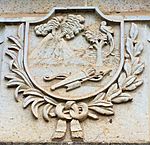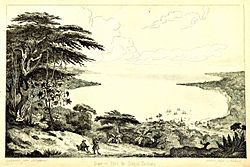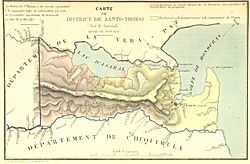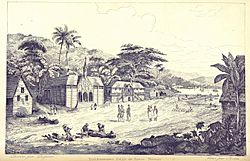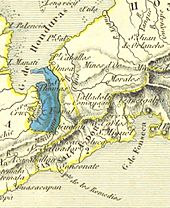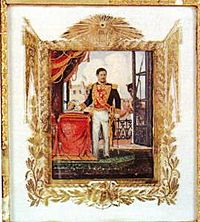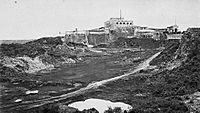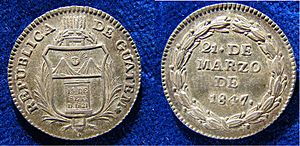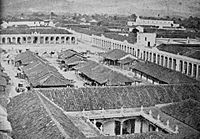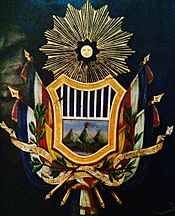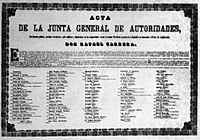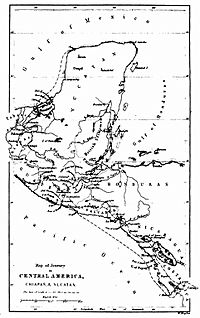Rafael Carrera facts for kids
Quick facts for kids
Rafael Carrera y Turcios
GCSG
|
|
|---|---|
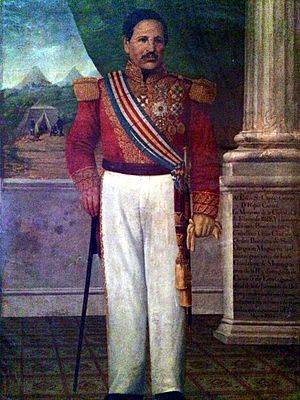 |
|
| 1st President of Guatemala | |
| In office 6 November 1851 – 14 April 1865 |
|
| Preceded by | Mariano Rivera Paz |
| Succeeded by | Pedro de Aycinena y Piñol |
| In office 21 March 1847 – 17 August 1848 |
|
| Preceded by | Position established |
| Succeeded by | Juan Antonio Martínez |
| 4th State President of Guatemala | |
| In office 4 December 1844 – 21 March 1847 |
|
| Preceded by | Mariano Paredes |
| Succeeded by | Position abolished |
| Personal details | |
| Born | 24 October 1814 Guatemala City, Kingdom of Guatemala, New Spain |
| Died | 14 April 1865 (aged 50) Guatemala City, Guatemala |
| Political party | Conservative |
| Spouse | Petrona Garcia Morales de Carrera |
| Children | José, Francisco, María Mercedes Carrera García |
| Parent | Simón Carrera y Juana Turcios |
| Residences | Mataquescuintla, Guatemala City |
| Occupation | Military |
| Signature |  |
José Rafael Carrera y Turcios (born October 24, 1814 – died April 14, 1865) was a very important leader in Guatemala. He served as president from 1844 to 1848 and again from 1851 until his death in 1865. In 1854, he was even named "President for life." During his time, Central American countries faced many challenges, like invasions, political fights, and local uprisings. Carrera became a powerful leader, known as a caudillo, especially among the native people.
He had strong support from the Catholic Church, conservative families, and many farmers and native people. He was a key figure in Guatemala's first thirty years of independence. He led a revolt against the liberal government of Mariano Gálvez and helped break up the Federal Republic of Central America. Because of this, later liberal governments often spoke badly of him, saying he was uneducated or just a puppet. However, Carrera cared about the native Guatemalans and protected their interests.
Contents
Early Life and Beginnings
Rafael Carrera was born on October 24, 1814, in Guatemala City. His family was not rich, and he was a mestizo, meaning he had mixed European and Indigenous heritage. He did not learn to read or write. He first worked on farms and then joined the army during a civil war from 1826 to 1829. In 1835, he left the army and became a farmer in Mataquescuintla, where he married Petrona García.
Rise to Power
By 1837, many people in the countryside were unhappy with Guatemala's liberal government. The leaders didn't understand how strong this unhappiness was. A serious cholera sickness made things worse, causing panic and helping Carrera gather peasants for an armed fight. With strong support from the Church, Carrera became the real ruler of much of Guatemala. He led a large uprising of native people and poor farmers in the eastern and southern parts of the country. This movement wanted to bring back many old religious traditions that the liberals had removed.
Even though liberal armies often pushed Carrera's forces out of cities, his followers would quickly take them back once the army left. For almost ten years, Carrera was happy being a military leader, respected by his followers. Conservative families, who had lost power to the liberals, decided to support Carrera. They hoped to regain their influence in Guatemala.
Battles with Morazán
Carrera was a skilled military leader. He used a mix of guerrilla tactics (small, surprise attacks) and traditional army fighting. His soldiers were not well-equipped, but they were good at fighting. In 1838, liberal forces led by Francisco Morazán invaded Guatemala. They killed Carrera's father-in-law, Pascual García, which made Carrera and his wife very angry.
Morazán's army destroyed villages and took their goods, forcing Carrera's men to hide in the mountains. Morazán thought Carrera was defeated and marched into Guatemala City. There, he was welcomed by some leaders. However, Carrera used this chance to regroup his forces.
Carrera attacked a small group of soldiers in Jutiapa and then won a battle near Guatemala City, though with many losses. In September, he tried to attack the capital but was defeated. Later, he was surrounded and wounded near Quetzaltenango. Morazán had a chance to kill Carrera but didn't, because he needed the support of Guatemalan peasants against other enemies. Instead, Morazán left Carrera with no weapons in a small fort.
However, another leader, Francisco Ferrera, gave Carrera weapons and convinced him to attack Guatemala City. Taking advantage of a general who tried to negotiate, Carrera surprised Guatemala City on April 13, 1839. The liberal leaders fled, and Carrera put Mariano Rivera Paz back in charge of Guatemala.
Taking Back Los Altos
On April 2, 1838, a group in Quetzaltenango created an independent state called Los Altos. Many liberal leaders who were against Carrera's government moved there. Los Altos was a very important economic region for Guatemala. The Guatemalan government tried to find a peaceful solution, but Los Altos refused. So, Guatemala sent Carrera and his army to take it back.
Carrera defeated the Los Altos general, Agustin Guzman, and marched into Quetzaltenango. He warned the city leaders that he would be merciful this time, but not if they challenged him again. Guzman and the leader of Los Altos were sent to Guatemala City and shown off as war trophies.
Morazán's Second Invasion
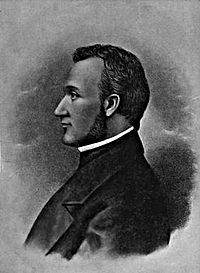
On March 18, 1840, General Morazán invaded Guatemala again with 1,500 soldiers. Carrera planned a clever defense. He pretended to flee, leading his army to a high point called Aceituno. Morazán easily took Guatemala City, thinking Carrera was defeated.
But Carrera launched a surprise attack, focusing fire on the city's main square. Morazán's soldiers were caught off guard and suffered heavy losses. They were also tired from their long march. Carrera, now a very experienced military leader, completely defeated Morazán.
Morazán had to flee in disguise to El Salvador. He was then forced into exile in Peru. In Guatemala, many of his soldiers were shot. This battle made Carrera even more powerful and marked the end of Morazán's influence in Central America. It also forced the conservative leaders to work with Carrera and his peasant supporters.
Guzmán, who had been freed by Morazán, returned to Quetzaltenango, and the leaders there quickly declared Los Altos independent again. But Carrera quickly returned with his army and took control. On April 2, 1840, he ordered many of the liberal city officials from Los Altos to be shot. He then brought Quetzaltenango and Los Altos back under Guatemala's control. This victory made Carrera even more respected by the native people, whom he protected.
Belgian Colony
In 1840, Belgium started supporting Carrera's government. A Belgian company became the manager of Santo Tomas de Castilla in Izabal. Even though the colony failed due to sickness, Belgium continued to support Carrera. However, Britain remained Guatemala's main business and political partner.
First Presidency
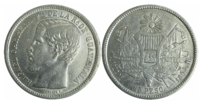
Rafael Carrera became president in 1844. On March 21, 1847, he declared Guatemala an independent republic, making him its first president.
Caste War of Yucatán
In Yucatán, a region north of Guatemala, a war began between native people and others. This was called the Caste War of Yucatán. It was partly about native lands being taken over for large farms. Native workers were also treated badly.
The war caused a lot of fear in Belize and Guatemala. Refugees from Yucatán fled to both areas. Some feared that Carrera, who was allied with Guatemalan natives, might support the uprisings.
Brief Exile to Mexico
During his first term, Carrera brought stability to Guatemala. But in 1848, liberal groups managed to force him out of office. Carrera resigned and went to Mexico. The new liberal government passed a law saying he would be executed if he returned. The liberals in Quetzaltenango declared Los Altos an independent state again.
Return to Guatemala
Carrera decided to return to Guatemala through Huehuetenango. He met with native leaders and told them they needed to stay united. Slowly, native communities began to form a new identity under Carrera's leadership.
When Carrera arrived in Chiantla, two people from Los Altos told him their soldiers would not fight his forces, fearing a native revolt. Carrera then hid with his native allies. He later met with a former friend, José Víctor Zavala, who agreed to serve under Carrera. This sent a strong message to Guatemala City that they would have to negotiate with Carrera.
Carrera returned to the Quetzaltenango area. He put Ignacio Yrigoyen in charge and told him to work with the native leaders to keep the region peaceful. A friend heard Yrigoyen say, "Now he is the King of the Indians, indeed!"
Carrera became commander-in-chief again, supported by the native communities. During his first presidency (1844-1848), he brought the country back to a more moderate rule. He also restored good relations with the Catholic Church, signing an agreement called the Concordat in 1854.
Second Presidency
Battle of La Arada
After Carrera returned in 1849, the president of El Salvador, Doroteo Vasconcelos, supported Guatemalan liberals who were against Carrera. By late 1850, Vasconcelos planned an open attack on Guatemala. He invited Honduras and Nicaragua to join, and Honduras agreed.
On January 4, 1851, Vasconcelos and the Honduran leader signed an alliance against Guatemala. Their combined army had 6,000 men. Guatemala could only gather 2,000 men, led by Carrera.
On January 28, 1851, Vasconcelos demanded that the Guatemalan president step down and that Carrera be exiled. Guatemala refused. The Allied army entered Guatemala.
The battle began on February 1, 1851, at La Arada. Carrera used a clever strategy. He pretended to retreat, drawing the enemy into a place he had chosen. He divided his army and placed his artillery in the center. He had only 1,500 men against 4,500.
The Allied troops attacked three times, but Carrera's men fought bravely. At a key moment, Carrera ordered a sugar cane field around the battle area to be set on fire. The invading army was surrounded by fire, the river, and Guatemalan soldiers. They panicked and retreated in disorder.
Carrera's army chased them to their borders. The Allied forces lost many men, prisoners, and weapons. Vasconcelos fled to El Salvador. Carrera then entered El Salvador, but was ordered by the Guatemalan president to return, as the Allies wanted peace.
Carrera Theater
Carrera loved opera, and on the advice of his mistress, he started building a large National Theater. It was named "Carrera Theater" in his honor. It was built in the old Central Square of Guatemala City. This was the first grand building constructed in Guatemala after it became a republic, showing that the country was finally enjoying some peace and wealth in the 1850s.
Concordat of 1854
| Concordat between the Holy See and the President of the Republic of Guatemala | |
| Created | 1852 |
| Ratified | 1854 |
| Location | |
| Authors | Fernando Lorenzana and Juan José de Aycinena y Piñol |
| Purpose | Through this treaty, Guatemala gave the education of the Guatemalan people to the regular orders of the Catholic Church, committed to respect the ecclesiastical properties and monasteries, authorized mandatory tithing and allowed the bishops to censor what was published in the country. |
The Concordat of 1854 was an agreement between Carrera and the Holy See (the Pope's government). It was signed in 1852 and approved in 1854. This agreement gave the Catholic Church control over education in Guatemala. It also protected Church property and allowed bishops to control what was published. In return, Guatemala gained some benefits, like keeping taxes from Church properties. This agreement greatly strengthened the link between the Church and the government in Guatemala. It lasted until 1871.
President for Life
In 1854, Carrera was declared "supreme and perpetual leader of the nation" for life. This meant he could choose who would replace him after he died. He held this position until his death on April 14, 1865. He tried to help the economy for landowners, but his presidency was mostly focused on military challenges. He fought a three-year war against Honduras, El Salvador, and Nicaragua. His rivalry with Gerardo Barrios, the president of El Salvador, led to the War of 1863. Carrera eventually won, taking control of San Salvador and influencing Honduras and Nicaragua. He worked closely with the Church and tried to maintain good relations with European countries. Before he died, Carrera chose his loyal soldier, Vicente Cerna y Cerna, as his successor.
Wyke-Aycinena Treaty: Belize Borders
| Wyke-Aycinena treaty | |
| Created | April 30, 1859 |
| Ratified | September 26, 1859 |
| Location | |
| Authors | Pedro de Aycinena y Piñol and Charles Lennox Wyke |
| Purpose | Define the borders between the British settlement of Belize and Guatemala. |
The area of Belize was long inhabited by the Maya peoples. Spain and later Guatemala claimed it, but they didn't really control it. British settlers and pirates had lived there since the 1600s, mainly for logging. Belize became a major trading center for Central America.
When Carrera came to power, he stopped complaining about Belize and set up a Guatemalan office there to look after Guatemala's interests. In the 1850s, the British wanted to settle border disputes with Central American countries. To get weapons to fight an American adventurer named William Walker, Carrera's government had to make a deal with the British about Belize.
On April 30, 1859, the Wyke-Aycinena treaty was signed between British and Guatemalan representatives. This treaty had two main parts:
- The first six articles clearly defined the border between Guatemala and Belize. Guatemala officially recognized that the United Kingdom owned Belize.
- The seventh article was about building a road between Belize City and Guatemala City. This road would help both countries with trade. However, the road was never built. First, they couldn't agree on the exact location. Later, the conservative government lost power in Guatemala in 1871, and the new liberal government canceled the treaty.
Rafael Carrera approved the treaty on May 1, 1859.
Death
Rafael Carrera died while still in office on April 14, 1865.
Legacy
Carrera didn't greatly improve the lives of all rural native people, but he did slow down the changes that later liberal governments brought, which often harmed native cultures. His rule set the stage for future governments in Guatemala. His success came from his military skill, his strong personality, and his ability to understand important issues quickly.
The Pope gave Carrera a special award, the Order of St. Gregory the Great, in 1854. One year after he died, coins were made in his honor with his face and the title: "Founder of the Republic of Guatemala."
See also
 In Spanish: Rafael Carrera para niños
In Spanish: Rafael Carrera para niños
|


